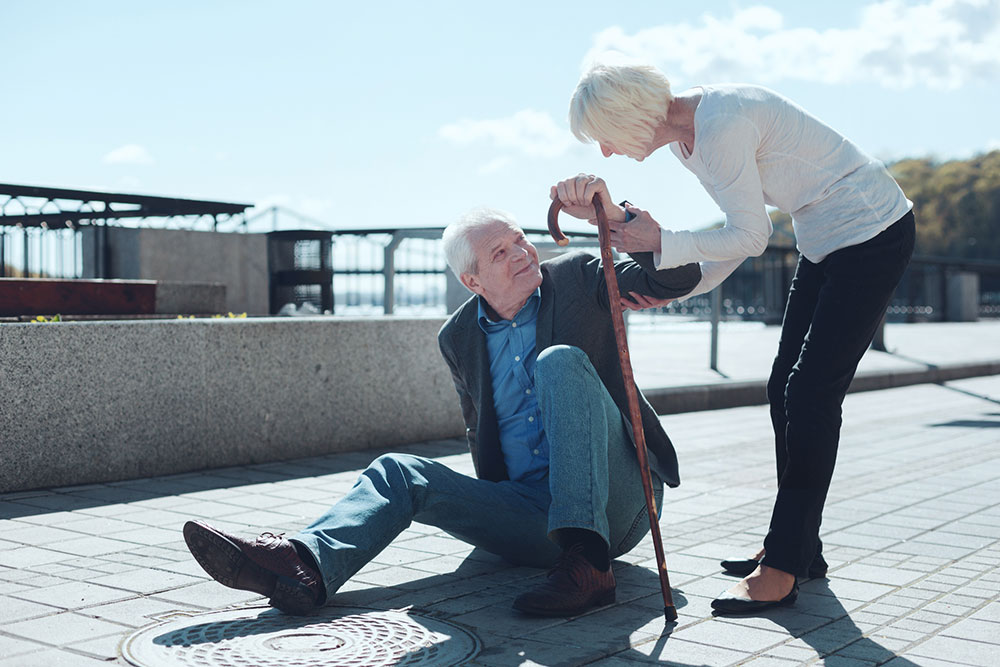Fall Prevention: What Can You Do to Protect Yourself?
by Elizabeth Heape-Caldwell, BS, MBA, CMC
August 10, 2019

Mrs. Hill lives in her own home and is fiercely independent. She is very active and enjoys attending bunco with her ladies group every week. However, last week on her way to the car, Mrs. Hill tripped over an extension cord in the garage and subsequently fell. She was transported to the emergency room with a suspicion of a broken hip. Mrs. Hill may now experience a long recovery time from something that may have been prevented.
According to the Center for Disease Control and Prevention,
- One out of five falls causes a serious injury such as broken bones or a head injury.
- Each year, 2.5 million older people are treated in emergency departments for fall injuries.
- Over 700,000 patients a year are hospitalized because of a fall injury, most often because of a head injury or hip fracture.
- Each year at least 250,000 older people are hospitalized for hip fractures.
- More than 95% of hip fractures are caused by falling, usually by falling sideways.
- Falls are the most common cause of traumatic brain injuries (TBI).
- Adjusted for inflation, the direct medical costs for fall injuries are $34 billion annually. Hospital costs account for two-thirds of the total. (Center for Disease Control and Prevention, 2015).
So, the question arises…..What causes people to fall? Numerous factors can cause unsteady gait and eventual falls to include:
- Poor eyesight can cause incidents of falling due to not seeing items in the way or clarity of what is being seen.
- Cognitive impairment can increase the incidents of falls. For example, monocular vision occurs in the later stages of dementia. The brain turns off the other eye and there is no longer any depth perception. This can cause frequent falls.
- Balance problems can be a perpetrator of falls because unsteady gait is present. If balance is an issue, the use of assistive devices such as a walker, can be beneficial.
- Medications have the potential to cause falls due to side effects. For example, Benadryl makes individuals very tired. Walking around while taking this medication may increase your chance of a fall.
- Consumption of alcohol can affect balance and lead to trips/falls.
Falls can also be a result of simple items within your home. Making small changes to where items are located can reduce the risk of falls. This includes:
- Removing throw rugs can assist with slipping and falling, especially in bathrooms and kitchens where wet surfaces are present.
- Placing rug grippers under rugs. This allows for rugs to grip to the floor and prevent slippage.
- Ensure clean pathways to prevent issues of tripping. Remove clutter or items in pathways.
- Secure cords and wires. Using a zip tie to put the cords together and out of the way is a helpful way of preventing tripping incidents over wires or cords.
- Avoid walking in the dark. Well lite areas are safer and assist with the prevention of falls or accidents.
- Wear proper shoes. Do not walk in slippers or socks. These items can make an individual stumble and fall.
- Keep moving! The more your body is used to rest, the more relaxed your muscles will become. With your doctor’s approval, consider going for walks, water aerobics, or tai chi.
- If you are taking medications known to cause tiredness, be sure to recognize the risk to your balance while taking.
- Ensure an adequate diet. Lack of proper nutrition can take a toll on your body and cause your balance to be affected.
- If you have stairs in your house, ensure railings are present. The hand railings should be on both sides and extend the length of the stairs.
According to recent statistics, one out of three individuals over the age of 65 experiences a fall each year. Once you fall, the risk of you falling again nearly doubles. However, to combat this risk the simple precautions listed above can save us from an unwanted trip to the emergency room and a possible long recovery time due to a serious injury.
 Elizabeth Heape-Caldwell, BS, MBA CMC is a Certified Aging Life Care Manager and the Chief Operating Officer at Elder Options, Inc. Elder Options supports older adults, the disabled and their families by creating care services that enable loved ones to experience A Life Lived Fully Every Day.
Elizabeth Heape-Caldwell, BS, MBA CMC is a Certified Aging Life Care Manager and the Chief Operating Officer at Elder Options, Inc. Elder Options supports older adults, the disabled and their families by creating care services that enable loved ones to experience A Life Lived Fully Every Day.

